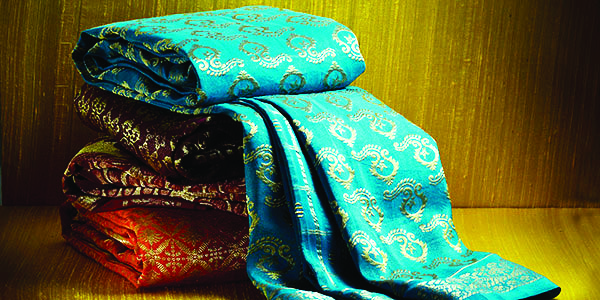Magical silk of Mysore
Known for its extraordinary quality and permanence of lustre, Mysore silk, as a purveyor of Karnataka’s rich culture, has found diversified usage with the passage of time while its sophistication and elegance remain undiluted

One hundred and eleven years ago, in the year 1912 CE, Maharaja Nalvadi Krishnaraja Wodeyar, the Ruler of Mysore, established a silk factory to meet the requirements of the royal family, courtiers, visiting dignitaries, and fabric for the uniform of the armed forces. He invested his time, money, and resources in the factory, and there is evidence to suggest that the Maharaja of Mysore inspected the Weaving Factory, which was then an annexe of the Silk Filature on Manandavadi Road, opposite the church in March 1930. We also learn that in January 1931, the government of His Highness, the Maharaja of Mysore, sent some quantities of ‘Mysore Silk’ to Switzerland to check the suitability and viability of expanding the factory and installing power looms for the production of high-grade silk fabrics. The government notification of that period records that as a result of these experiments, arrangements were made to install ten additional power looms in Mysore as an adjunct to the Silk Filature for producing high-grade silk fabrics. In November 1932, the government noted ‘with satisfaction that the products of the new Silk Factory at Mysore have proved popular and that forward orders for them are being registered.’
This was the beginning of global brand recognition for this unique product, for which the Karnataka Silk Industries Corporation (KSIC), established in 1980, now holds the Geographical Indicator. It is worth recalling that after Independence, the management of the Silk Weaving factory was transferred to the Directorate of Sericulture.
Known for its extraordinary quality and permanence of lustre, Mysore silk is “an integral part of Karnataka’s culture.” From times immemorial, the people of this region always wore some kind of silk while participating in a ritual – be it secular or spiritual. The fabric draws its fame from the purity of the silk, its lustre, softness, and richness of its natural colour, which gives it precedence over all other silks. However, it may be noted that the production of Mysore Silk originated in and is confined to the geographical area of Mysore district. While the manufacturing unit(s) of Mysore Silk are situated within the Mysore City Corporation limits, Ramanagara, the main market for procuring cocoons is also located in close proximity. It is one of the largest cocoon markets in the world and is often called the ‘silk town.’ There are two types of silk cocoons — yellow and white, with the latter fetching a higher price than the yellow ones, both because of the quality and size. Just before the advent of COVID, an average of 40 metric tons were being transacted in this market every day.
The cocoons are transported to the raw silk manufacturing unit, which is spread over 15 acres in Narasipura, where they are sorted for quality. They are placed in a semi-automatic machine that pulls barely visible threads of silk from them. A single cocoon produces 800-900 metres of yarn, but only 400-600 metres are usable. The unit manufactures raw silk yarn and transfers it to meet the raw material requirement of the silk weaving unit in Mysore, which is about 29 km away. According to production requirements, the yarn is taken to the next process of soaking. Here, coconut oil is used as it makes the fabric soft for temporary colouring. The temporary colouring is done to identify the warps and the wefts. This is followed by winding, a process common to both making the warps and the wefts. The silk thread is then ‘doubled’ by running two threads simultaneously from two different bobbins onto a single bobbin and passed onto twisting.
The intricate and painstaking production process by the weavers ensures that every aspect of the saree is perfect, and each of these creations retains an extraordinary sheen of the fabric, purity of the Zari, the distinctive drape, a wonderful non-crush quality, and a butter-soft feel, which gives an elegant look to anyone who wears it. These sarees are passed on from one generation to the next, and therefore have a ‘heirloom’ aspect because durability is one of the USPs of this product. The silk is dyed using natural pigments and woven into intricate yet subtle patterns featuring motifs of birds, fruits, leaves, etc.
Traditionally, Mysore silk sarees showcased a single colour in all its glory. However, with the passage of time, weavers started exploring and experimenting to bring out Mysore silk sarees with eye-catching colour combinations. These gorgeous sarees are lightweight with minimalistic designs. Despite this, Mysore silk sarees are the preferred festive wear choice for many and are revered for their smooth texture, vibrant colours, and artistic motifs. While most Mysore silk sarees have traditional Zari motifs, embroidery and bandhani designs have also become integral parts of the sarees in recent times.
While women have continued to adorn the sarees for several generations, most men had given up the traditional headwear for which the Dewans and nobility of Mysore were known. In fact, a century ago, about forty percent of silk production went into the intricate turbans, as well as army uniforms. As diversification is the name of the game, silk products for men now include materials for shirts, kurtas, neckties, pocket squares, and wraps. Many urban women have also moved to salwar-kameez, uppers, and adornments for the head and shoulders. Mysore silk represents the epitome of elegance and sophistication, intricate craftsmanship, and timeless beauty, making it a cherished possession for many.
The writer superannuated as the Director of the LBSNAA after 36 years in the IAS, and is currently a historian and policy analyst.



